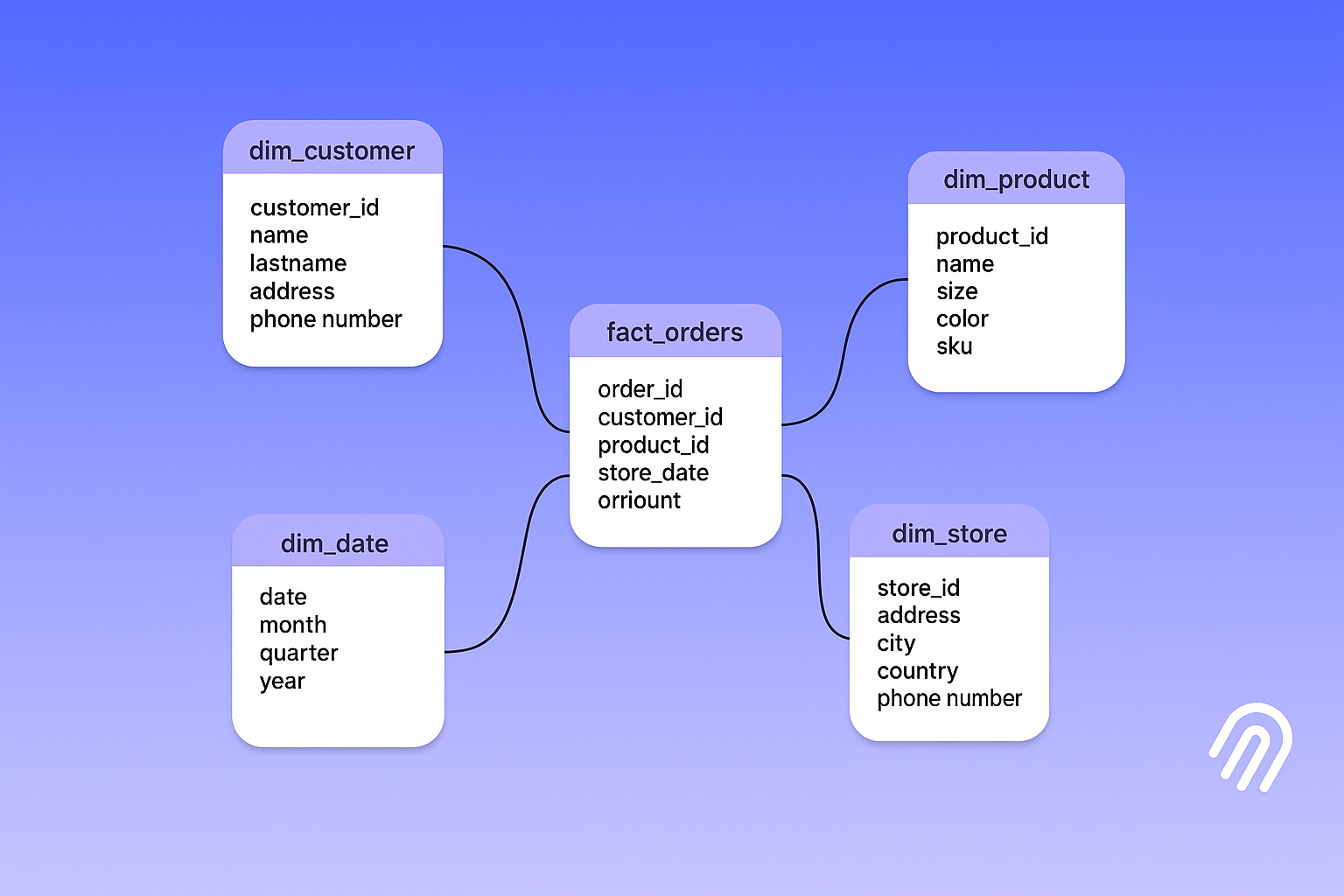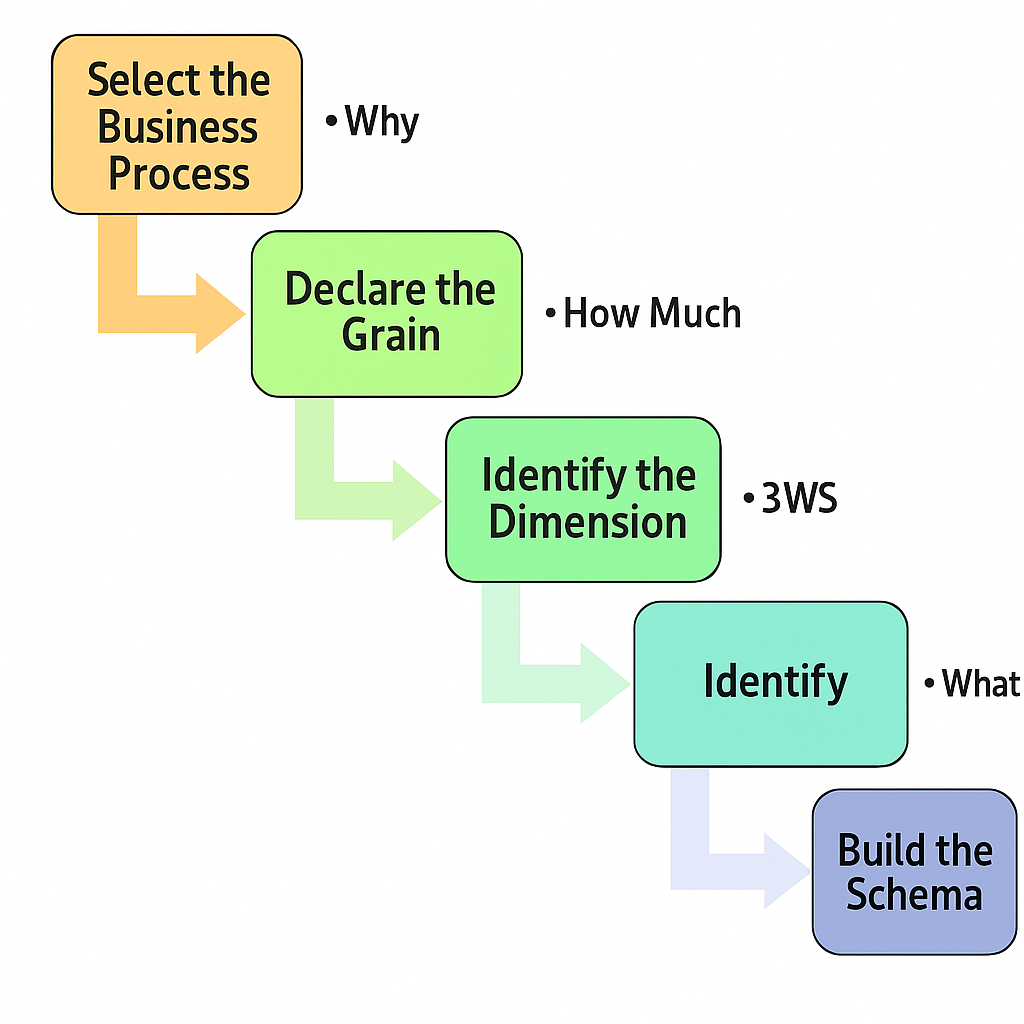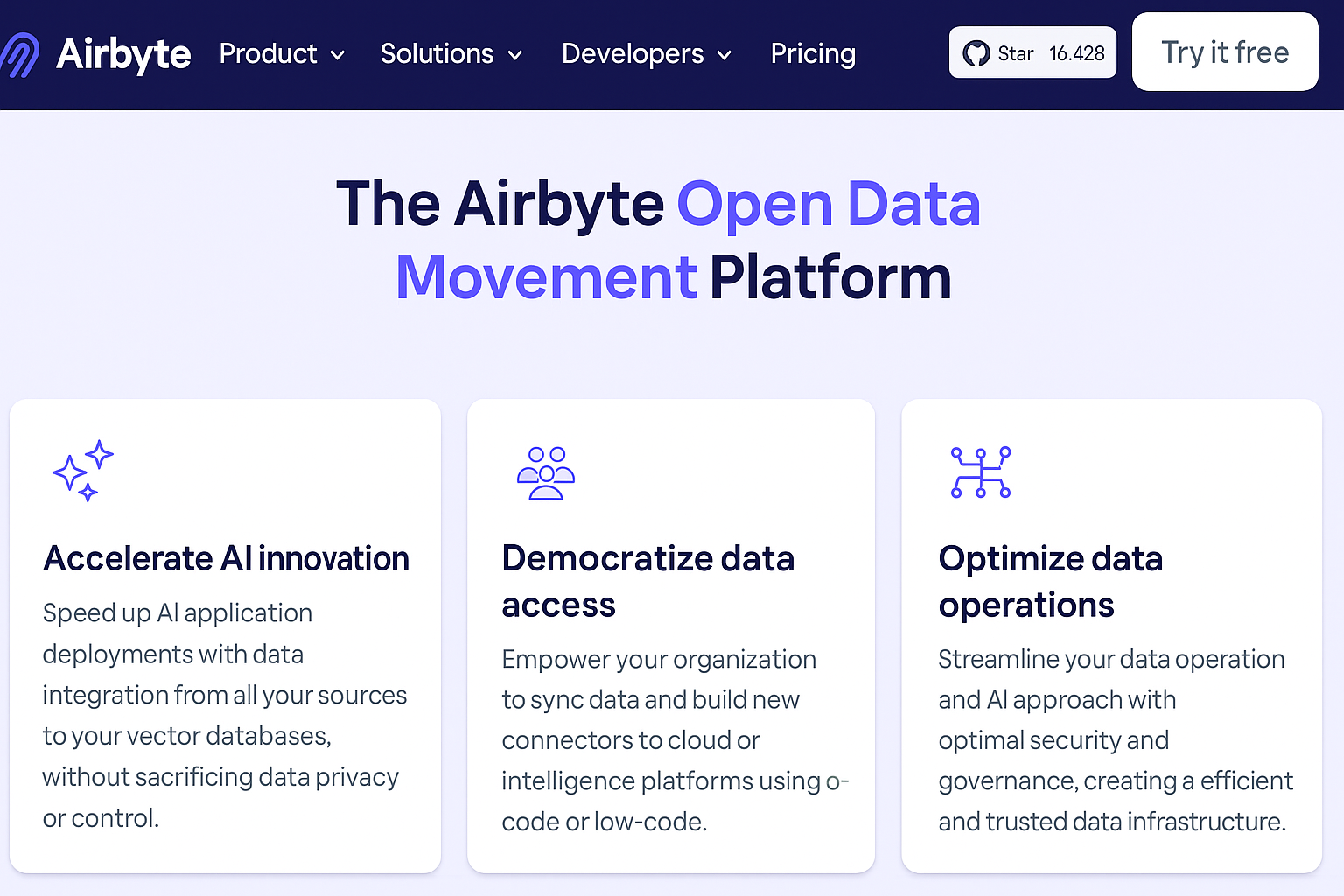Dimensional Data Modeling: Examples, Schema, & Design
Summarize this article with:
✨ AI Generated Summary
Dimensional data modeling remains essential for analytics due to its simplicity, performance, flexibility, and enhanced data quality, especially when modernized with AI-driven automation, real-time integration, and cloud-native architectures. Key components include fact tables, dimension tables, and keys, with common schema designs like star, snowflake, and fact constellation schemas. AI and automation improve schema design, slowly changing dimension management, and predictive modeling, while real-time data integration ensures up-to-date analytics, making dimensional modeling adaptable for diverse industries and future-proofing BI and AI applications.
When your dimensional model fails to capture real-time customer behavior changes, marketing campaigns miss their targets by hours or days. Meanwhile, many data professionals struggle with data-quality issues that can corrupt even the most carefully designed star schemas, while AI-powered competitors leverage automated modeling techniques to deploy analytics-ready data products in weeks rather than months. You face an impossible choice: continue with traditional dimensional-modeling approaches that worked in batch-processing eras, or risk disruption while learning entirely new paradigms that promise real-time insights and automated optimization.
The solution lies in modernizing dimensional data modeling through AI-driven automation, real-time integration patterns, and cloud-native architectures that preserve the methodology's core strengths while addressing contemporary data challenges. This comprehensive guide explores how to enhance traditional dimensional modeling with cutting-edge techniques, from automated schema generation to streaming fact tables, enabling you to build analytics infrastructure that scales with modern data demands while maintaining the query performance and business usability that made dimensional modeling indispensable.
What Is Dimensional Data Modeling and Why Does It Matter Today?
Dimensional data modeling is a conceptual data modeling method that enables you to organize data in a comprehensible and usable form. It is optimized for analysis and reporting, allowing you to analyze large amounts of data. Representing information in a well-structured manner can provide you with the capability to generate impactful insights from complex datasets.
Despite being decades old, dimensional modeling has proven remarkably adaptable to modern data challenges. Contemporary implementations leverage cloud-native architectures, integrate with machine-learning pipelines, and support real-time analytics while preserving the methodology's fundamental strengths. The approach remains the gold standard for analytical data organization because it balances query performance, business-user accessibility, and development efficiency in ways that newer methodologies struggle to match.
Why Should You Choose Dimensional Data Modeling Over Alternative Approaches?
Simple Querying
Dimensional data modeling offers an intuitive schema that enables you to query data almost effortlessly. You can use this data to make data-driven business decisions. The denormalized structure eliminates complex joins that plague normalized transactional systems, allowing business analysts to construct queries without deep technical expertise.
Better Performance
The database schema produced by dimensional data modeling is optimized for better performance than traditional normalized models. In a dimensional data model, the data is denormalized. This eliminates the requirement of complex joins, minimizing data redundancy and allowing operations on numbers rather than texts. Modern cloud data warehouses like Snowflake and BigQuery further amplify these performance advantages through columnar storage and automated optimization.
Flexibility
The dimensional data models are robust in nature yet adaptable to changes, which can be made according to your business requirements. The flexibility offered by these models makes it easier for you to consolidate data from different platforms. Conformed dimensions enable consistent business metrics across multiple business processes, creating a unified analytical foundation that scales with organizational complexity.
Enhanced Data Quality
Dimensional data modeling significantly improves data quality by simplifying the format of complex data, reducing efforts while performing advanced analytics. It aids in eliminating errors and inconsistencies in your data, refining it into a well-structured format. The structured approach to fact and dimension separation creates natural validation points where data-quality rules can be applied systematically.
What Are the Essential Components of Dimensional Data Models?
Fact tables, dimension tables, and database keys are the most crucial components when discussing dimensional data modeling. Let's explore each element in detail.
1. Facts and Fact Tables
Facts are quantitative data elements that represent various business metrics, such as performance or outcomes. For example, metrics like revenue, profit, and product quantity could be considered facts.
The fact table stores the business-facts data with foreign keys that are referenced to the dimension table. Each row in the fact table highlights the recorded transaction, while columns display attributes or events, like total sales, quantity, and date.
Modern fact-table implementations often include additional metadata like data-lineage timestamps, processing-batch identifiers, and data-quality flags that support automated governance and monitoring systems.
2. Dimensions and Dimension Tables
Dimensions are descriptive data elements that enrich the fact elements. For example, attributes like product name, customer name, and customer address describe the data stored in the facts table. The dimension table holds the dimensional factors of the data, representing additional information about the transaction in each fact-table row.
Contemporary dimension tables frequently incorporate hierarchical attributes, temporal versioning, and semantic metadata that support advanced analytics scenarios.
3. Keys
Both the fact and dimension tables are linked to one another using a set of keys. These keys include the primary key and the foreign key. The primary key is part of the dimension table that contains unique, not-null information about each individual component of the dimensional data. The foreign key, on the other hand, usually references the primary key of the dimensions table. This allows you to join different tables together to get a holistic view of data.
Modern key-management strategies often employ surrogate keys generated through hash algorithms or auto-incrementing sequences that provide stability across source-system changes.
How Do Relational and Dimensional Data Models Compare?
Modern data architectures frequently employ hybrid approaches where transactional systems maintain normalized relational structures for operational efficiency, while dimensional models serve analytical workloads through ETL processes that transform normalized data into denormalized analytical structures.
What Design Patterns Should You Consider for Dimensional Data Modeling?
It is beneficial to understand the schema design patterns that you can use to implement dimensional data models. These patterns define the arrangement of facts and dimensions within a database to achieve optimized performance.
Star Schema Design

Star schema is an architectural design that resembles a star-like structure. In this design pattern, a fact table is located at the center of the star and surrounded by multiple dimension tables.
Snowflake Schema Design

Snowflake schema design is an extension of the star pattern, in which the same set of dimensions are normalized and further divided into sub-dimensions, resulting in more related tables.
Fact Constellation Schema Design

Fact constellation schema design, also known as the Galaxy schema, is useful for representing multi-dimensional models. It defines a collection of fact tables connected to common dimension tables.
How Can AI and Automation Transform Your Dimensional Modeling Process?
Generative AI for Schema Design and Optimization
Modern AI tools can generate schemas from natural-language requirements and optimize them based on query patterns.
Automated Slowly Changing Dimension Management
Machine-learning algorithms analyze attribute-volatility patterns to recommend optimal SCD strategies and generate transformation logic dynamically.
Predictive Modeling Integration
AI-enhanced dimensional models can double as machine-learning feature stores, ensuring consistent definitions across analytics and operational systems.
What Role Does Real-Time Integration Play in Modern Dimensional Modeling?
Streaming Fact Table Implementation
Change-data-capture systems continuously update fact tables as business events occur, achieving near real-time analytical freshness.
Dynamic Dimension Management
Versioned dimension tables with temporal validity periods handle concurrent updates without disrupting analytical queries.
Hybrid Batch and Streaming Architectures
Lambda architectures merge streaming updates with batch-processed historical data, providing both depth and freshness.
How Should You Implement Dimensional Data Modeling in Practice?

- Identify the Business Process – define metrics, KPIs, and dimensions.
- Select Granularity – often start at the finest grain; consider storage cost and performance.
- Determine Dimensions – design tables with unique, not-null primary keys.
- Consolidate the Facts – store metrics in fact tables with foreign keys to dimensions.
- Build a Schema – choose star, snowflake, or fact constellation and implement via infrastructure as code and automated tests.
What Challenges Should You Anticipate with Dimensional Data Models?
- Data Quality Issues – mitigated through automated validation and anomaly detection.
- Historical Data Tracking – addressed with slowly changing dimensions and bitemporal modeling.
- Performance Tuning – cloud-native platforms offer automated optimization recommendations.
- Data Integration – tools like Airbyte streamline ingestion with change-data capture and schema evolution management.

What Are the Primary Use Cases for Dimensional Data Models?
- Banking Sector – fraud analysis and performance reporting.
- Healthcare System – treatment effectiveness and population-health management.
- Media and Entertainment – engagement analytics and real-time personalization.
- Retail and E-commerce – inventory optimization and customer-lifetime-value analysis.
- Manufacturing and IoT – predictive maintenance and quality control based on sensor data.
How Can You Future-Proof Your Dimensional Modeling Strategy?
To succeed, embrace automation, real-time integration, and AI-driven optimization while preserving dimensional modeling's core strengths in usability and performance. Prioritize metadata-driven development, comprehensive testing, and cloud-native architectures that scale with business growth. Doing so will position your organization to support both today's BI needs and tomorrow's AI-driven applications.
Frequently Asked Questions
What's the difference between star schema and snowflake schema in dimensional modeling?
Star schema has a central fact table linked to denormalized dimensions for simpler, faster queries. Snowflake schema normalizes dimensions into multiple tables, saving storage but increasing joins. Star favors performance and usability; snowflake favors storage efficiency.
How do you handle slowly changing dimensions in modern dimensional modeling?
Slowly changing dimensions (SCDs) manage historical changes in dimension attributes: Type 1 overwrites old values, Type 2 adds new records with versioning, and Type 3 keeps old and new values in separate columns. Automation and AI can optimize strategy selection.
Can dimensional modeling work effectively with real-time data streams?
Yes. Dimensional modeling can handle real-time data using streaming fact tables, change-data-capture updates, and dynamic dimension management. Lambda architectures merge streaming and batch data, ensuring analytical depth, consistency, and real-time freshness in queries.
What role does AI play in automating dimensional modeling processes?
AI automates dimensional modeling by generating schemas from natural-language requirements, optimizing designs based on query patterns, managing slowly changing dimensions intelligently, and enabling consistent, ML-ready feature stores across analytics and operational systems
How do you choose the right granularity for fact tables in dimensional modeling?
Start with the finest granularity that supports analytics, balancing storage costs and query performance. Atomic-level detail maximizes flexibility, while modern cloud warehouses allow dynamic aggregation, making storage cheaper than compute for scalable analytics solutions.
What are the key data quality challenges in dimensional modeling and how do you address them?
Key challenges include duplicates, missing keys, inconsistent attributes, and late-arriving facts. Address them with automated validation, anomaly detection, surrogate keys, and real-time monitoring, while ensuring data lineage tracking and systematic quality checks during fact and dimension table loads.

.webp)
